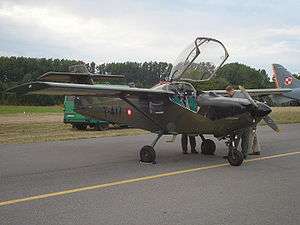Saab Safari
| MFI-15 Safari | |
|---|---|
 | |
| A Saab MFI-17 Supporter, Radom Air Show 2007 | |
| Role | Primary trainer |
| Designer | Björn Andreasson |
| First flight | 26 February 1971 |
| Introduction | 1972 |
| Status | Active |
| Primary users | Danish Air Force Royal Norwegian Air Force Pakistan Air Force |
| Produced | 1971-1979 |
| Number built | 462 |
| Developed from | MFI-9 Junior |
| Variants | MFI-17 Mushshak |
Saab MFI-15 Safari, also known as the Saab MFI-17 Supporter, is a propeller-powered basic trainer aircraft used by several air forces.
Development and design
On 11 July 1969 Saab flew the prototype (SE-301) of a two/three-seat civil/military trainer or general utility aircraft allocated the designation Saab-MFI 15. Developed at Malmö Flygindustri, it was powered by a 119 kW Avco Lycoming IO-320-B2 flat-four engine and with a conventional low-set tailplane. The latter was later modified to a T-tail configuration to minimise damage when operating from rough airfields.
On 26 February 1971 the prototype was flown with the more powerful Avco Lycoming IO-360-A1B6 air-cooled flat-4 piston engine, which became the standard powerplant for the production version, now designated as the Saab Safari. A braced shoulder-wing monoplane with fixed tricycle landing gear, available optionally with tail-wheel landing gear, it provides side-by-side enclosed accommodation for two and has dual controls as standard. It has forward-swept wings to maintain correct centre of gravity. This design constraint applies also to the ARV Super2 and the Bölkow Bo 208 Junior, the latter a license-built version of the Malmö MFI-9 Junior.
A military version designated originally Saab-MFI 17 was flown on 6 July 1972 and differed from the Safari by being equipped more specifically for use as a military trainer, or for artillery observation or forward air control and liaison.; this version was later named Saab Supporter.[1] In August 1978 Saab flew a prototype version of the Safari with a 157 kW Continental flat-six turbocharged engine; designated Safari TS, it did not enter production. A trainer based on the Safari's design was built in kit form for assembly in Pakistan as the Mushshak, with 92 aircraft delivered to the Pakistani air force. A later batch of 120 aircraft was built entirely in Pakistan.[2]
Of the 250 fully assembled aircraft built by Saab, the majority were bought by private fliers. Including the 212 Pakistani CKD or locally built aircraft, a total of 462 versions of the Safari were produced. The Royal Norwegian Air Force purchased their Safaris in 1981. Today 16 of the aircraft are stationed at Bardufoss Air Station.
A variant with a stretched wing made of composite materials, the MFI-18, was tested during the 1980s in Sweden. Also fitted with provision for skis, this version never went into production. The supporter was also used as a highly efficient COIN aircraft, Experience with the earlier MFI 9B Minicom during the Biafran Civil war encouraged Saab to develop the Supporter as a close support aircraft carrying an assortment of underwing stores including rockets and gun pods.
Variants
- MFI-15 Safari – original civilian variant.
- MFI-17 Supporter – Saab's designation for the military variant, Danish designation T-17.
- Saab Safari TS – a prototype fitted with a 157 kW (210 hp) turbocharged piston engine.
- MFI-17 Mushshak – improved version of MFI-17 Supporter manufactured by Pakistan Aeronautical Complex under license.
- PAC Super Mushshak – upgraded Pakistan-manufactured variant of the MFI-17 Mushshak.
Operators
MFI-17 Supporter
- Pakistan Air Force – 28 delivered by Saab, 92 assembled from knock down kits
Former Operators
- Zambia Air Force – 20
MFI-17 Mushshak
- Royal Air Force of Oman – eight
- Pakistan Air Force – 149
- Syrian Air Force – six
Specifications (Safari)
Data from SAAB Trainers: Safir, SAAB 105, & Supporter
General characteristics
- Crew: two, pilot and student
- Capacity: one passenger
- Length: 7.00 m (23 ft)
- Wingspan: 8.85 m (29 ft ½ in)
- Height: 2.60 m (8 ft 6½ in)
- Wing area: 11.90 m² (128.1 ft²)
- Empty weight: 690 kg (1,521 lb)
- Max. takeoff weight: 1,200 kg (2,645 lb)
- Powerplant: 1 × Avco Lycoming IO-360-A1B6 fuel-injected, air-cooled flat-4 piston engine, 200 hp (149 kW)
Performance
- Maximum speed: 196 kts (362 km/h)
- Cruise speed: 110 kts
- Stall speed: 55 kts ()
- Service ceiling: 6,100 m (20,000 ft)
See also
- Related development
- Aircraft of comparable role, configuration and era
References
- ↑ Aviastar.org/ Saab-MFI 15/17 Safari-Supporter
- ↑ Blood, Peter R. (1996). Pakistan: A Country Study. Diane. p. 298. ISBN 9780788136313.
- ↑ Schrøder, Hans (1991). "Royal Danish Airforce". Ed. Kay S. Nielsen. Tøjhusmuseet, 1991, p. 1–64. ISBN 87-89022-24-6.
External links
| Wikimedia Commons has media related to Saab Safari. |